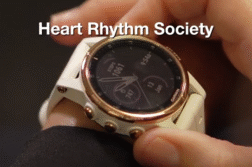HOBOKEN, N.J. (Ivanhoe Newswire)— People who have coronary artery disease have a buildup of calcium deposits in their arteries. They may have low blood flow through their heart, and as a result, may be at higher risk for heart attack or stroke. A treatment that doctors have used for years to break up kidney stones is now approved to break up blockages in the arteries. Shockwave therapy
Barbara Colella is a restaurateur and an avid traveler, but after months of feeling short of breath, she had a sudden episode that landed her in the hospital.
“In January, I got up and I took my dog to the end of my driveway, and I felt like a horse had kicked me in the chest,” Barbara told Ivanhoe.
Barbara’s coronary arteries were 99.9 percent blocked. Doctors would have performed bypass surgery, but Barbara was also positive for COVID. Instead, Barbara was hospitalized for several weeks, which she says was a blessing.
Barbara Colella shared, “I am so fortunate that the Food and Drug Administration approved this procedure while I was recovering in the hospital.”
It’s called intravascular lithotripsy and it works using soundwaves. First, doctors pass a catheter through an arm vein or leg artery to reach arteries clogged with hard plaque.
“It’s a balloon, inflate the balloon, and then you emit, uh, these waves, which are shattering the calcium, which is in the wall of the vessel into tiny, tiny, tiny, tiny pieces,” said Haroon Faraz, MD, an interventional cardiologist at Hackensack University Medical Center.
The ground-up calcium remains safely within the wall of the artery, and doctors are able to continue with a traditional procedure to restore blood flow.
“The vessel becomes very compliant, and then it makes it easier for the treatment of the blockage with a stent and a balloon,” Dr. Faraz noted.
As her blood flow improved, Barbara began feeling better quickly.
“It was like, I was a new person,” Barbara exclaimed.
Back to work and back on the road.
The shockwave device was given breakthrough designation by the FDA in mid-February. Dr. Faraz says an earlier clinical trial for the device, The DISRUPT CAD-3 Trial, showed that the shockwave was safe and effective.
Contributors to this news report include: Cyndy McGrath, Producer; Kirk Manson, Videographer; Roque Correa, Editor.
To receive a free weekly e-mail on medical breakthroughs from Ivanhoe, sign up at: http://www.ivanhoe.com/ftk
Source:
https://www.cdc.gov/heartdisease/facts.htm
MEDICAL BREAKTHROUGHS
RESEARCH SUMMARY
TOPIC: SHOCKWAVE THERAPY OPENS CLOGGED ARTERIES
REPORT: MB #4934
SHOCKWAVE BACKGROUND: Coronary heart disease is also known as coronary atherosclerosis, which can cause vascular stenosis or occlusion and further leads to heart disease. Seven million deaths worldwide are caused by this disease. Current treatments include drug therapy, percutaneous coronary intervention (PCI), or coronary artery bypass grafting (CABG). Although these methods are effective in reopening the blood vessels of the patients, they cannot eliminate microvascular occlusion. In some cases, the patient’s prognosis can be poor. Shockwave therapy was developed in Switzerland and Germany and passed the EC certification in 2004. It has been practiced in Switzerland, Germany, and Italy, and in Asia prior to now.
DIAGNOSING CORONARY HEART DISEASE: Coronary heart disease is a condition caused by a buildup of plaque in the heart’s arteries. These arteries bring oxygen-rich blood to the heart and a blockage in the coronary artery is a serious condition. When plaque builds along the artery wall, it causes them to become stiff and narrow. Healthy arteries are smooth and elastic. The build up of plaque will slow blood flow to the heart causing it to not get the amount of oxygen it needs. Plaque could also break away from the walls; when this happens you could experience a sudden heart attack or cardiac death. Symptoms include chest pain, commonly called angina, which feels like aching, burning, fullness, heaviness, numbness, pressure, squeezing, weakness or dizziness. You may also feel this type of pain in your arms, back, jaw, neck, and shoulder. In women, the symptoms are harder to detect. Nausea, sweating, fatigue, or shortness of breath can join the typical pressure-like chest pain.
(Source: https://www.webmd.com/heart-disease/guide/heart-disease-coronary-artery-disease )
SHOCKWAVE NEW TECHNOLOGY: Cardiac shockwave therapy is a new development in cardiovascular therapies. It’s a non-invasive procedure that uses a low intensity shock to stimulate angiogenesis, which is the development of new blood vessels. Further studies state that the safety of the procedure seems to be high in patients with refractory angina, a chronic condition characterized by angina. The therapy consists of nine sessions with three sessions per week. One hundred impulses were applied during treatment to one spot with up to 1,200 impulses to the patient per session. The shock wave was tracked using ultrasound and placed through a membrane at the target treatment zone. The provider is able to see the target zone through the ultrasound technique and the inflatable balloon-like cushion is filled as it delivers the shockwaves through the arteries.
(Source: https://www.ncbi.nlm.nih.gov/pmc/articles/PMC5864803/)
FOR MORE INFORMATION ON THIS REPORT, PLEASE CONTACT:
MARY MCGEEVER
551-795-1675
If this story or any other Ivanhoe story has impacted your life or prompted you or someone you know to seek or change treatments, please let us know by contacting Marjorie Bekaert Thomas at mthomas@ivanhoe.com




